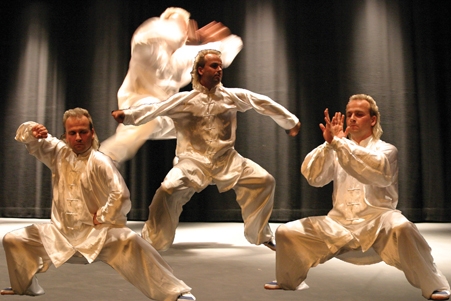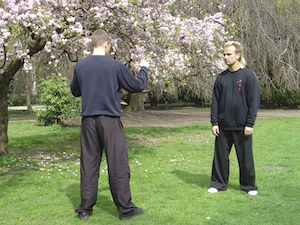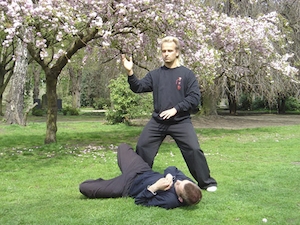A discourse on the meaning of the term, ‘Internal Martial Art’
Many responses are possible when people consider the martial aspect of Taijiquan: sometimes they prefer to avoid the subject, sometimes they reject it, and sometimes they take an overly romantic and exaggerated view.
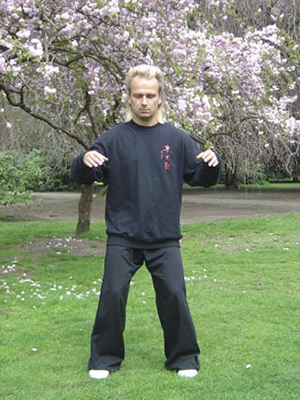
Most exponents and most teachers, if they are honest with themselves, lack a real relationship with, and understanding of this aspect of Taijiquan. Their level of skill is often not high enough to properly understand the practical aspects and the corresponding terms. When reading the classical texts of Taijiquan we can assume a high level on the part of the author of the texts, but it is precisely this high level and the way it is expressed that once more render the text incomprehensible to most readers.
Even the term “internal martial art” (nei jia quan), although relatively widespread, probably would benefit from a clear terminological analysis:
Martial Art (wu shu, here: quan)
The term martial art (wu = fight, war; shu = technique, art, or quan = fist, here as a synonym for martial art) is taken to mean a system of fighting skills that should be understood neither in the sporting sense, (‘combat sport’ or ‘martial competition sport’) nor in the reduced martial sense (‘soldiering skills’). Rather, we refer to an effective system of the skills described above that deserve the term ‘art’ because, firstly, they exceed normal abilities in this field and secondly (and indeed due to the first factor) they must involve all levels of being. Without the latter aspect, the skills would not meet their own high aims and the term ‘art’ would not be justified. In the classical texts, however, the term ‘art’ is not translated in the sense of “artificial.” The transformation of a content, that may be original in nature, into an art form such as the one known as “modern” or “state-sponsored”
Wu Shu (guo jia wu shu), which expresses its actual meaning only in a symbolic manner, or which in other cases, makes only concessions in this direction, is thus not to be included in the original definition of the term. For this reason these modern developments of wu shu will not be considered in this article.
To sum up: martial art represents one of the most basic concepts for defending oneself in the most holistic and effective sense, in the process of which all areas of human existence are to be involved and refined. Perfection would be the ultimate goal.
The “internal” (nei) aspect of martial art
Right at the start, it should be said, that if one hopes to meet the requirements of martial art as defined in Section 1, there can be no purely internal martial art. This can only be a part. Martial art in its complete manifestation is neither purely internal nor purely external. A complete martial art, and only such an art, that is worthy to serve as a path through life, has both internal and external aspects.
However, the purpose of this article is to look closely at the term “internal” martial art. Although this internal aspect is the source of all external aspects it seems that, at least in our times, it is often given less consideration and is often wrongly interpreted. There is therefore very good reason for looking closer at this area of martial arts. The internal aspect is less obvious; it is subtle and cannot be grasped or learned quickly. The “internal” is the source, the spirit, from which all further things are formed and transformed to an energy that is then expressed externally (wai) by the body.
Taijiquan is a martial art that generally seems exclusively soft and gentle to the uninformed observer (“overcoming hardness with softness”, yi rou ke gang). For this reason it is therefore is automatically regarded as an “internal” art. This internal development, however, already paves the way for “external” (i.e. opposed in nature) skills. We must understand that hardness can arise from great softness, as it stated in the Classics: “(an) iron (bar) wrapped (hidden) in cotton” (mian li cang zhen) and vice-versa: “softness mixed with hardness (solidity)“ (yi rou ji gang).
Taijiquan is chiefly concerned with the development of so-called internal energies which in martial application manifest externally as strength. A frequently emphasised formula is that this internal strength should be used instead of muscle power, and that one should not oppose the strength of the opponent with one’s own strength, but instead yield (“overcoming hardness with softness“, yi rou ke gang). In respect of the use of muscle power, this is not quite correct. As my Grandmaster Chen Xiao Wang so finely puts it: “With Qi alone no one can get out of bed in the morning.” This means that every physical movement relies on muscle movement. It is actually a question of extremely finely harmonised movements between internal and external powers that are so subtle, that the actual movement is no longer noticed; it then seems as if the muscle power was replaced. It would be better to say, “Through the most subtle movement, the muscle effort required for the desired result is minimised. In this way one becomes able to “overcome a force of 1000 pounds with skill” (yi qiao po qian jin). The goal here is, of course, the same as everywhere else: achieving the greatest result with minimum effort.
In this way the inner and the outer can interact, from level to level, becoming increasingly subtle (ethereal) and seemingly “invisible”, i.e. smaller. If we take a step further into the mystique of Taijiquan, the movements become so small and fine that they virtually no longer take place. As the Classics say, “The large (coarse) movements are no better than the small ones. The small movements are no better than non-movement. From non-movement, true movement arises.”
Viewed neutrally, the following sentence would thus be true: “Initiated internally, given form externally, there is no inside and no outside.” This is not a phrase from the Classics, it’s just something I thought up. But it already contains the Two Essential Pillars of Taijiquan: the Three Internal Harmonies (nei san he, see below) and the Three External Harmonies (wai san he, see further below). In perfection, the two seem to act together indivisibly and can no longer be distinguished from each other. Taijiquan is a martial art that has the principle of yin and yang as its core. This is the harmonisation of hard and soft, above and below, left and right, and: internal and external!
We need to cultivate mental unity (xin yu yi he = connecting heart and attention). Conflicting feelings or thoughts are the greatest barrier to our determination. Only pure determination, arising from inner truth, can generate a total, integral and fully focussed energy that then unites with the powers of the body (Qi yu li he = combining internal and external strength). Only this can move the body as a united whole (jin yu gu he = linking the tendons with the bones). Mental unity develops energetic wholeness. This in turn enables to body to act in its optimum form. This means that the Three Internal Harmonies have been achieved (nei san he). To achieve this end the body must be united in its external aspects: all areas of the physical body must be arranged and structured in relation to each other so that everything can be optimally transmitted (linking shoulders with hips (jian yu kua he), linking elbows with knees (zhou yu xi he) and linking hands with feet (shou he zu he).
This means that the Three External Harmonies have been achieved (wai san he).
Clarity in body and mind means the absence of all types of disruptive feelings. These include emotions, such as fear, anger, high spirits, etc. There should also be an absence of physical inadequacies, which would impede the effective transmission of force in a physical sense. These shortcomings, referred to colloquially as ‘internal and external blocks’ can weaken one’s own actions in many ways and ultimately render them ineffective.
As shown above, this description of the overall nature of ‘internal’ and ‘external’ already deals with an area which is often described as being ‘internal’. In other words, much of what I describe as ‘external’ is for the novice, already situated in the internal. This can be seen in the Taijiquan Classics, which makes no mention of the term ‘internal martial art’ as is used today. Bearing this in mind it cannot be satisfactory to classify a martial art – if it lays claim to completeness – as being just one or the other. This article would therefore be much too simplistic if it were to apply a concept of purely internal energy versus external muscle power.
On the other hand: even though many of the classical texts of Shaolinquan, (which is regarded as an ‘external’ art) are identical to those of Taijiquan, and this system also includes a high proportion of Qigong, the training processes of the two systems (at least as we know them today) would seem very different.
We will thus let this definition of ‘internal’ and ‘external’ schools suffice. Nonetheless, I believe that both systems, in perfection, achieve a unified physical movement with an impulse from internal to external, although without temporal delay. There is therefore no differentiation between the two; they are simultaneous in sequence, indivisible from each other and thus immediate, so that in this sense there is no longer ‘internal and external.’
Before I run the risk of complicating things, I will turn to the basic concept of Taijiquan as expressed in combat and attempt to reduce it to a generally applicable principle and render it comprehensible.
Due to the nature of the article, I will deal only with the foundation of the material. To this end, I will (as before) add the classical terminology in brackets and thus help the reader to gain access to the much deeper classical meanings. I assume that the reader has access to such classical texts and I will thus not describe these terms further. For the novice I hope that the article already contains enough information so that he will accept not being able to make these links. In order not to stretch the limits of the article further, I would also remark that the descriptions relate only to genuinely physical encounters. We assume that all diplomatic negotiations have already failed or that there was never any opportunity for them. Moreover, there is no escape route. So now we will devote ourselves exclusively, to the moment that no one wants to experience, but which so many glorify in their training: a real physical attack, with all its shock and nastiness.
Assuming that a person, who is mortally endangered, is subject to extreme stress, it is proven that the range of movement available to someone in this situation is significantly reduced in comparison to normal conditions. The knees become weak, signs of paralysis set in, and the simplest coordination is suddenly no longer possible. This renders most of the techniques that are taught in normal martial arts courses impractical, as they are too complicated. I recall various demonstrations in which well-known martial arts masters wanted, for instance, to carry out technique variations on one leg and already lost their balance due to stage fright. I have complete understanding for these people, but if things already go wrong due to nerves in a socially amenable situation, I wonder what will happen under the greatest possible stress – mortal danger?
The movements must therefore be simple and direct. Since my logical mind will be unable to act, the naturalness of my movement plays a crucial role. Finally, nothing can work without balance. We can thus summarize the following qualities as fundamental:
- naturalness (zi ran)
- simplicity (chun)
- balance (zhong)
It is exclusively within the framework of these three aspects that our technique is defined:
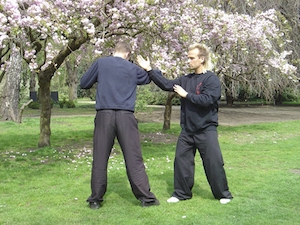
Our mind must be calm and balanced. That can only be a joke, you may think. How can I remain calm when I’m in fear of my life? The answer is quite simple – by not being there at all. That is to say, I am in a state of absence. My personality, my ego, my logical mind – none of these is involved. Through my training, I must be able to create a sense of emptiness in myself. Through this emptiness, I am able to establish, or to rediscover, a relationship of trust with my inherent nature. It fights – I don’t fight. “The best fight is the fight that I didn’t conduct” – this classical phrase has a highly pragmatic meaning. The escape route is cut off, I have no other choice, I have to face the situation. And yet, I will fight best when I don’t fight. That is, when the ME doesn’t fight. I must be able to leave myself totally. I, my logical mind and my ego, am too slow, have too many wrong decisions, reactions and emotions.
I must be able to recognize the Wuji behind the Taiji. My actions are in Taiji, but the source is in Wuji. Thus in the actual situation it happens that one does not consciously experience the fight; only afterwards, when the film, so to speak, replays itself. How else, without my own absence, could I otherwise achieve naturalness? It will hardly be possible with me as the conditioned being that I am. This is the meaning of ‘calmness’: letting go of oneself, as the highest form of ‘fang song’ – ‘relaxation’ and ‘release’. This enables me to have a clear mind, which must be unified and focussed. A clear concept is needed that does not force me to weigh up the options: “The opponent does not move, I do not move; the opponent moves, I am already there” (bi bu dong, wo bu dong. bi yi dong, wo xian dong) – so goes a classical saying. I am not the first to move. But in the moment that the other starts to attack, I end the matter with 100% determination. With regard to this, I must realize a few essential factors about fighting:
It is not the fist that attacks me, but the one who moves the fist.
It is not the pain suffered by the opponent – or a possible reconsideration of the matter on his part – that is my salvation, but instead the temporary incapacity of the opponent.
These two points have a simple consequence:
- I do not defend myself by parrying the blows of the opponent, but by parrying the opponent himself.
- I need to hit him directly and resolutely to ensure that a further attack will not lead to my downfall. This consistent approach leaves no room for a role of a victim.
It may sound violent to the uninitiated, but everyone who has experienced such situations knows how difficult it is to survive ‘the real thing’. Don’t forget: in the situation described, we are already in the middle of physical aggression, not before it! Once again the majority of so-called martial artists fail because they are aware of their technique, but not of the actual situation. In modern professions, where physical conflict is the order of the day, often things are completely reversed: the technique may be faulty sometimes but the energy of the situation is often clearer. This leads us inescapably to a further fundamental meaning of the sentence “The best fight is the one not fought” – My action must be so immediate and direct that a fight does not even come into being. Every ‘fight’ describes a temporal sequence of blows and other fighting moves. This is, so to speak, a sum of mistakes, i.e. failed actions and counter-actions; because otherwise the fight would already have been finished. If however an attack is met directly with a single but conclusive action, then it would be more appropriate to speak of a knockdown, and not of a fight. There was no ‘course of events’ in that sense. Consider all the legendary fights of the great Taiji masters such as Yang Luchan or Chen Fake. They weren’t great fights to talk about – nothing like those famous bouts between Ali and Frazier or Foreman. Not so: there was an attack, and at the same moment the aggressor was sent flying, or received a blow that dropped him immediately. In this sense there is no temporal sequence between attack and defence, it more or less happens at the same moment, whereby – as said – the attack starts first but the defence arrives first. If we were to perfect this process, it would be quite practical to start so early, that the opponent reconsiders, before he has really started, although he had already started, and thus no physical confrontation in any kind takes place. It would already have been countered during the mental preparation. A famous example of this is the tale of the two samurai warriors who stand motionless opposite each other until one of them gives up. Such ability leads to the projection of self-assurance which generally rules me out as a “random” victim. But be careful: this requires a high level of skill and not just pacifistic intentions. Even according to the Buddhist principle of perfect emptiness, which gives an attack no basis, this must be genuine and not simply wished or hoped for. We cannot create peace just by ‘wanting’ as long as we still have so much aggression hidden deep within us. These feelings radiate out unconsciously and this is exactly what provides enough stimulus for an attack. In short: it is only possible for us to give the opponent no basis for his attack, when we really do not have one anywhere in ourselves, and this is difficult. An analogy we can cite is the famous story of the sparrow that was unable to fly from Yang Luchan’s shoulder because he gave the bird no platform for take-off. He was able to pre-empt every movement of the bird by yielding first. Indeed, for a person this needs to function in just the same way on the mental level, so that the aggressor is likewise unable to find a platform for movement, neither physically, nor mentally.
There is a further saying in Taijiquan that secures both parties in the conflict: “The opponent moves slowly, I move slowly; the opponent moves fast, I move fast.” This means that assuming inner ‘absence’, and the resulting naturalness, my inner self acts in exactly the way in which it is confronted. If the attack is harmless, then my initiative is too. If it is very serious and determined, then I am just the same. In this way, I avoid the problem of overreacting or under-reacting. I am, so to speak, the opponent’s shadow. This must, as said, take place in a state of naturalness because there is no room or time here for conscious decisions. In order to achieve this simplicity and immediacy in my ability to adapt, I must be focussed and, in Taijiquan, that means centred. Through my own balance and the body structure developed on this basis I manage – with increasingly good Taijiquan – to move my entire body in a way that can no longer be disrupted from outside. This enables me to express all my energies with full focus through the entire body. By orienting myself towards the opponent’s centre, I ensure that my hits land only in fundamental areas: in the places where the blow renders the opponent unable to fight. Interestingly, one can here apply a sentence from the famous German ‘Brockhaus’ encyclopaedia, about the term “Wushu”: “Wushu is based on inner calm, concentration of the movements and postures and on internalizing all actions on a point of focus.”

Furthermore, this centre orientation creates a higher level, with an increasingly fine perception of the opponent’s action. This progresses, not only to the point where the action has not yet taken place, but to the point where the opponent himself does not even know that he is about to move. In other words, shortly after the movement initiation, but shortly before the protagonist realizes it. This is why Chen Wangting, founder of the Chen style, says: “No one knows me, but I know them all.” Once I can control the opponent’s centre, I can accompany, and adapt to, all his movements, which means that he can no longer reach me. As already I previously in the quote by Chen Wangting, through our control of the opponent, he is unable to control our centre. This means he is unable to know us, i.e. our action always surprises him. And this is independent of whether the movement is fast, slow, hidden, or obvious. Fully in accord with the quote by Chen Changxing, the teacher of Yang Luchan: “Hit so that your hand is not seen. If it is then seen, nothing can then be done against it.” This is not a question of dexterity, speed or feinting manoeuvres, it is simply exercising the principle, and the resulting control of centre.
This always takes place within the framework of “warding off” (peng), of “yielding” (lü), of “pressing” (ji), of “pushing” (an), of “pulling down” (cai), of “splitting” (lie), of “elbow“ (zhou) and of “shoulder” (kao), and within the 5 movement directions and their elements (wu xing). But these 8 basic techniques too (in Chen style 13 basic techniques: “hitting from below to above” (teng), “avoiding from above to below” (shan), “twisting” (zhi), “becoming empty” (kong) and “remaining in the principle” (huo)), as well as the 5 stepping directions, arise from the nature of the situation, not from my will. As my will is so completely absent, we also need to have no worries of philosophical or ethical nature. Where there is no will, there is also no suffering. The technique of Taijiquan can, in the way described here, never be used in a negative manner because there is no “me” which can do this. Thus there is also nothing that wants anything or would have an individual initiative (wu wei). This ties in with the image of water that, according to Laotse (Daodejing Verse 8) “adapts to all and nonetheless wants nothing itself”. Similarly, the “bridge” of the attack is decisive for the concept set out here and it can thus be used only for defence.
It is the process of “giving up oneself” described above that also contains the enormous possibility for spiritual development in Taijiquan. Through the overcoming of the ‘me’ and the related principle, I manage to overcome temporal limitations: from the inconstant to the constant, from the transitory to the unified, and to the eternal. In short: from confusion to Taiji and from Taiji to Wuji.
The form within Taijiquan must thus be trained in a way that reveals its simple and direct nature in martial application. This technique must be embodied within the form in an inner and outer structure that can no longer be overcome from outside. It should be meditative, so that one’s attention can penetrate deep into the inner regions. Through the resulting freedom from mental and physical barriers, further practice should create a state of naturalness that reveals correct intuitive knowledge and action in each situation. Therefore two things should be developed that are inseparable within the Taijiquan training process:
- On the mental level, a state of original naturalness should be revealed, that can act independently of our character and socialization, and a physical body should be formed that allows this inner naturalness to express itself to 100%.
- Wisdom arises through undivided (holistic) understanding. This wisdom in Taijiquan is not subject to divisions and can thus be expressed mentally and physically.
Naturally, this is only a brief overview of the ways in which Taijiquan may actually be applied. The way to master this concept is, of course, through correct, serious and persistent training. But I hope that I have been able to shed a little light on a subject that is often so misunderstood.
Author: Jan Silberstorff
became the first Western indoor student and family disciple of Grandmaster Chen Xiaowang in 1993 and now teaches in 15 countries around the world as a 20th generation sucessor of the Chen Family.
Jan co-founded the World Chen Taijiquan Association and is leader of the German section. He is a champion of many Taijiquan tournaments in both Europe and China and has published books, articles, DVDs, and produced a TV series on Taijiquan. He is currently dividing his time between living and working in Brazil and Germany.
Images: Jan Silbertorff and Taiji-Europa

